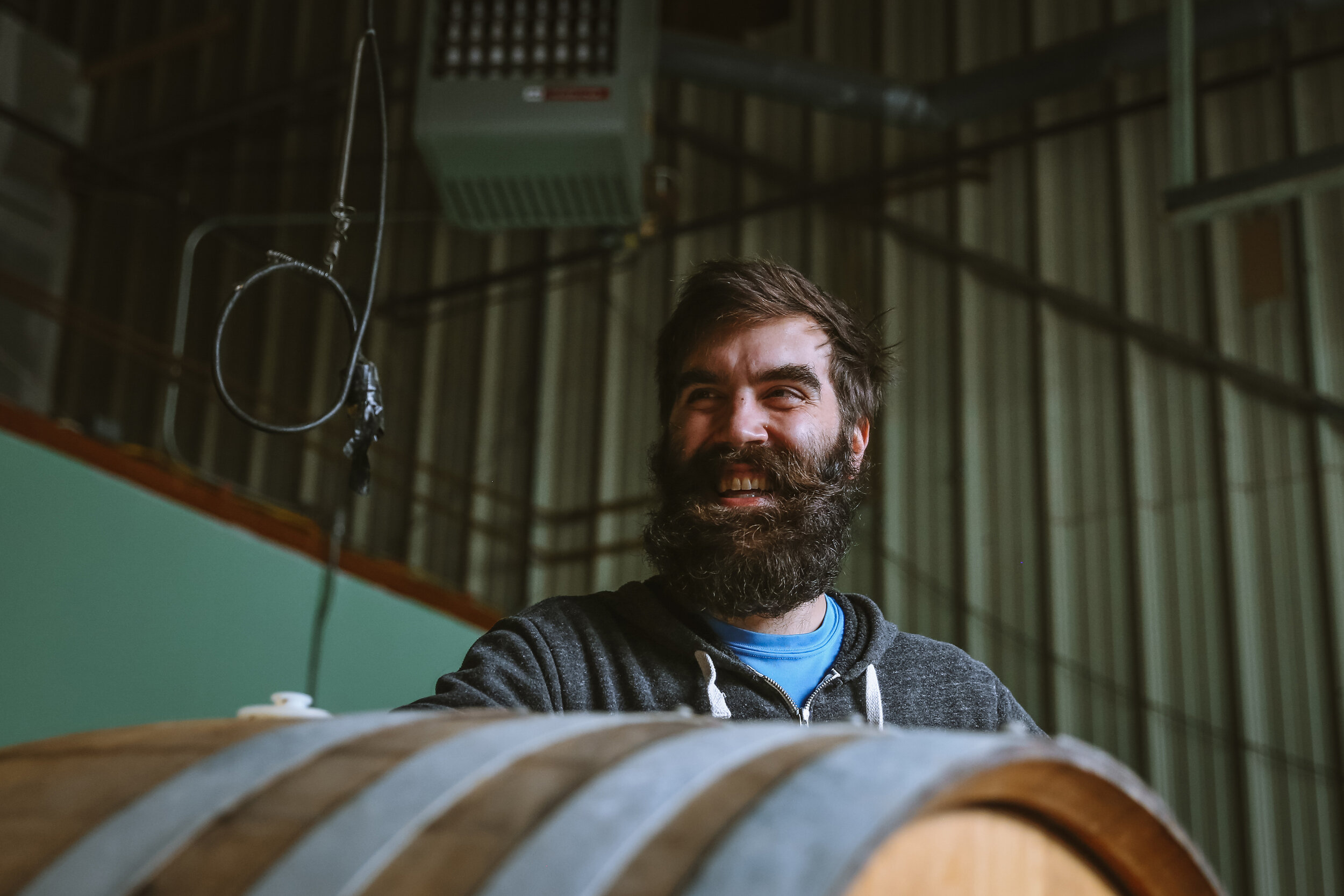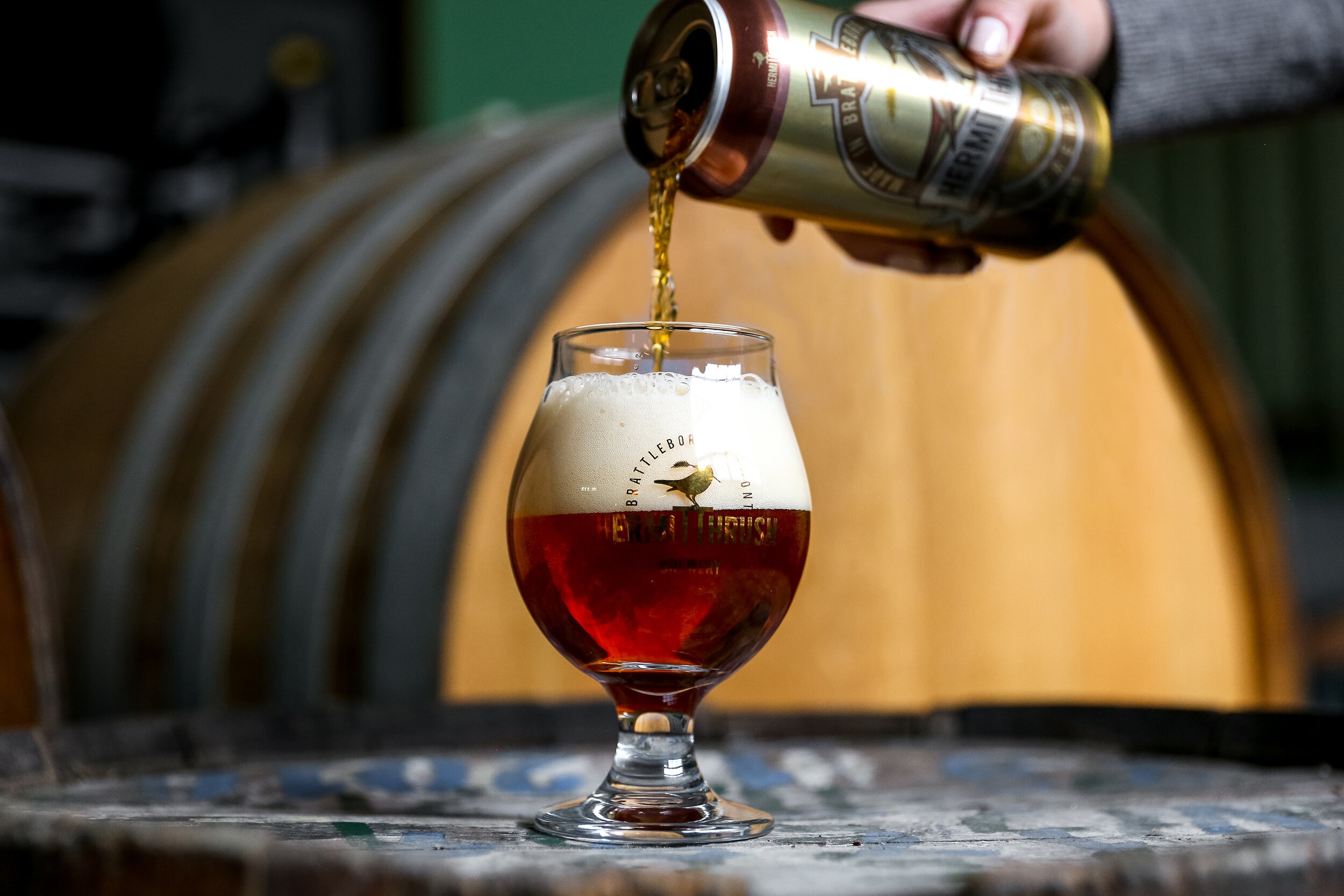I know I’m in New England when the snow starts—and when signs start appearing on Route 91 with simple instructions: “Don’t Crowd the Plow.”
“Be cool, don’t crowd the plow, man,” I whisper to myself, trying to mimic the lackadaisical drawl of the last beertender I met in Vermont. The temperature keeps dropping as I continue north from New York City, and I start daydreaming about past trips to the Green Mountain State, lazy afternoons spent outside on a taproom patio in the land of IPAs.
But there won’t be any Vermont-Style IPAs waiting for me at the end of this trip.
By the time I pull into the parking lot of Hermit Thrush Brewery in Brattleboro, Vermont, the snow has stopped falling, leaving the mountains looming beyond the brewery perfectly dusted with white. Even the parking lots here are scenic, I think to myself. At the sound of my car door slamming, a chipmunk hurls itself into a tree, and I remember the one that scurried past the outdoor tasting room during my last visit here in June. They must be Hermit Thrush fans.
They wouldn’t be alone. Not even snow and sleet and a 34-degree day are enough to discourage visitors from dropping by the makeshift outdoor taproom. It’s just after noon, and two people are already seated outside with an early lunch, awaiting pours of sour beer. I follow the sidewalk down the steep hill toward the brewery’s official taproom, which has been closed to the public since March.
Brewery co-founders Chris Gagne and Avery Schwenk are inside, both sporting winter-ready Vermont beards under their masks. The room features a patina of real Vermont, too. The painted cement floors are still the black and red of the Chrysler dealership that occupied this space in the 1950s; the 210-year-old wood panels adorning the walls were salvaged from a local barn. “We wanted to recover as much as we could when we set out on construction,” says Schwenk. “Our neighbor just so happened to have recently deconstructed a barn.” He remembers the days—or was it weeks?—of sanding each panel by hand. It was worth it, he laughs—giving new life to local resources is part of the brewery’s ethos.
As Gagne turns to pour us a sample of Party Jam, a kettle-soured beer that’s fragrant with blackberries, I catch a glimpse of the back of his sweatshirt. “Yes, they’re all sour,” it says.
Gagne’s interest in sour beer started well before much of the craft beer industry had caught on. As a master’s student based outside of Philadelphia, he had begun homebrewing with wild yeast. During that time, he also reconnected with Schwenk—the two had been friends as undergrads at Swarthmore, but drifted apart post-graduation—after he’d moved back to the area from Quebec. Schwenk, too, had cultivated an appreciation for sour and wild beers in the intervening time. “Sour beer was, I think, much more of a thing up in Quebec,” he says.
As the two fell out of love with urban life, they started taking road trips to Vermont. The drives gave Gagne and Schwenk a solid block of eight hours to discuss their ideas for the future, and their dwindling passion for their current career paths as a social worker and a paramedic, respectively.
“I think on one of those trips, he pitched the idea of opening up a brewery here in Vermont. And I said, ‘Sure,’” says Schwenk, “And within six months we both quit our jobs and moved up to Vermont.”
That was just over six years ago, back when, outside of Belgian imports, sour and wild styles were still hard to find. The brewery’s general manager, Joan Bulzacchelli—whose first encounter with sourness in beer was a bottle of Duchesse de Bourgogne—still remembers the challenge of those early years.
“I was pouring beer at a festival and every customer would ask, ‘Is this one sour? What about that one, is that one sour?’ So, I just made a sign that said, ‘YES, THEY’RE ALL SOUR,’” says Bulzacchelli. The straightforward, four-word explanation stuck, and has since become a de facto motto for the brewery.
At any given moment, Hermit Thrush may be serving as many as 50 unique beers that, yes, are always sour. Today, the to-go counter consists of four shelves packed with colorful cans, each featuring a shimmering golden silhouette of a hermit thrush. The brewery’s namesake is Vermont’s state bird, but it represents more than just locality. Schwenk notes that the thrushes have a unique, double voice box that allows them to weave complex songs; one voice box maintains the structure of the melody, while the other sings the chords. It’s an almost too-perfect metaphor for the brewery—for the complex flavors born of its house culture, and the way those fermentation profiles mingle with the distinct expressions of locally grown ingredients.
Back on that shelf full of glistening birds, the variety is stark, even if all of the beers are united in their sourness. There is Party Jam—the closest thing the brewery has to a core range—which sees an ongoing variety of fruits added to a consistent kettle-soured base. A Sour IPA, called Green SIPA, is heavily hopped exclusively with cones grown less than 20 minutes from the brewery. There is Rowdy Monk, a Belgium Quadrupel that comes in swinging at 14.5% after spending 18 months in red wine and scotch barrels. The brewery even made a Stout for the Black Is Beautiful initiative, spearheaded by Weathered Souls Brewing Company in San Antonio, Texas. From this release, it raised $25,000 for The Roots Social Justice Center, ACLU Vermont, and the Equal Justice Initiative by donating 100% of gross sales. Naturally, the team put their own twist on the recipe and made a sour version.
The hermit thrush is a local signifier, but it might also be a canary in the coalmine. According to Audubon Society projections, the bird would leave Vermont entirely if the climate were to warm by just 1.5° Celsius more. For a brewery whose mission relies on sustainability, it’s an apt symbol.
Gagne and Schwenk offer to take me on a tour of the brewhouse, and we duck behind the empty bar to an area that the public doesn’t usually get to see, even without the safety restrictions put in place because of COVID-19. We pass two seven-barrel oak foeders (the smallest in the brewery’s collection) on the way to a closet-sized room that few other breweries in the country have installed. It’s a biomass-powered boiler room.
“When we were starting out we knew there’s no way we’re running the brewery on fossil fuels,” says Gagne. This sentiment of environmental stewardship permeates every aspect of the brewery, from this energy source to the beers’ ingredients, from its waste (when I visit, they are finishing a urine diversion system that literally turns waste into fertilizer) to its branding (its four-pack holders are 100% recyclable).
Gagne digs his hand into what looks like a vat of hamster food to pull up a handful of pellets. It’s what the brewhouse is running on today, and every day. “They’re made from all the sawdust produced by the lumber industry here in Vermont,” he says. These small pellets are composed of wood shavings that would otherwise be considered refuse.
“So as far as I know, and definitely when we started, we were the only wood-pellet-fueled brewery in existence,” says Schwenk. While there are other biomass-powered breweries elsewhere in the world (the bulk of them owned by multinational beverage corporations like Diageo and Heineken), they’re not common. A brewery in Denmark is now powered by carbon-neutral wood chips, but it installed its boiler in 2015, almost a year after Hermit Thrush teamed up with a “mad genius plumber” to custom fabricate its system.
These biomass wood pellets are used in boilers all over the state to heat private homes. Even with customization, the converted boilers have certain quirks that can cause disturbances during brew days. “It’s not a normal brewhouse,” says Bulzacchelli. “When you’re firing it up, you need to know how long you’re going to need the hot water and prepare for that.” But the team seems to have adjusted to these quotidian inconveniences—maybe because what they’re striving to protect is staring them in the face from every window.
“I was pouring beer at a festival and every customer would ask, ‘Is this one sour? What about that one, is that one sour?’ So, I just made a sign that said, ‘YES, THEY’RE ALL SOUR.’”
Hermit Thrush’s wide-ranging beers are all packaged on the same canning line, housed at a second facility that’s less than 10 minutes away from the brewery’s main site. The surrounding area looks uncannily like the postcards that fill the racks on gift shop counters in downtown Brattleboro. A picturesque forest encircles the building, snow resting softly on the fiery red and buttercup-yellow leaves.
As expected, some thoughtful upgrades have been made to the machinery to reduce waste as much as possible. “On most canning lines, right here,” Hermit Thrush’s cellars manager and sustainability coordinator Chuck Soucy points to a nozzle on the line, “the cans would be rinsed with clean water. But instead we use ionized air. It acts like static cling to release particulate from the inside of the can.” Gagne jumps in, “It’s usually about an ounce [of water] per can, a whole ounce for each one of these,” he says, motioning to the towering pallets of cans that fill a corner of the warehouse.
Soucy reminds me that, even if they were able to capture that runoff and use it as gray water, too much of it would still go down the drain. “And how are you going to use that much clean, fresh water, just to pre-clean cans? No,” Soucy says. “We’re not doing that.”
Water isn’t the only unnecessary waste the canning line avoids. Instead of purging the cans with carbon dioxide and then bottom-filling them, Hermit Thrush uses a counter-pressure system. This specialized machine allows cans to be completely filled and pressurized with CO2. Then, the can fills with beer exactly as quickly as it’s emptied of CO2, so there is both less oxygen in the final package and less CO2 wasted.
“This is how we see a lot of our sustainability efforts,” says Soucy. “Yes, it’s better from a waste standpoint and better for our bottom line. But it’s also better for customers. There’s almost no oxygen left in these cans; you can age them forever.”
That’s often how things seem to work out at Hermit Thrush: Sustainability isn’t necessarily an end in itself—it’s just one step towards making the highest-quality beer.
Tucked behind the canning line is a room where 600 barrels are housed, stacked four high in neat rows, towering well above our heads. One thing makes this barrel room different, and more environmentally conscious, than many others in the industry: The temperature isn’t regulated during the summer months, and is only heated slightly during the frigid Vermont winters. Otherwise, there are no changes to the ambient conditions.
This is one of the reasons Gagne loves barrel-aged beer. “It’s making a beer without using any kind of cooling energy,” he says. Instead, the barrels breathe with the local environment, expanding and shrinking just as the flora outside shifts with the seasons. And in the right conditions, the team makes spontaneously fermented beer in their two metal coolships.
That scenic wood is where the yeast for the coolship series of beers comes from. “Wind blows right across the forest and creates a little vortex in this corner,” says Gagne. “What that does is fling out any solids. So we get a ton of cells—we’ll see high krausen in two days.”
“This whole place is a big yeast propagator,” he continues, gesturing around the space. “I mean the only thing that would make this yeast go away is if the environment here totally changed,” says Schwenk. The two founders look at each other and burst out laughing. “Although, that’s happening I guess. That’s what we want to stop happening,” says Schwenk.
The brewery’s house culture was sourced from multiple environments across southern Vermont: an apple orchard in Dummerston, a berry farm in East Dover, and another local farm in West Brattleboro. From those samples, a unique culture was isolated that imparts different flavors depending on where it’s pitched. In the brewery’s barrel-aged beers, it has plenty of time to produce nutty flavors and deep, apricot-like fruit notes. In the kettle sours, it creates more light, tropical fruit aromas. Even in the brewery’s most heavily hopped beers, yeast-derived stone fruit notes sing an octave higher than the hops’ own aromatic compounds. “It gives our beer a signature flavor and taste of place,” says Bulzacchelli.
More taste of place comes from family-owned Four Star Farms across the border in Northfield, Massachusetts, where the brewery sources almost 100% of its hops. “It’s really quality stuff. It’s flavors that you don’t get from the Pacific Northwest because it’s grown in the Massachusetts River Valley,” says Gagne.
“For the last six years, it’s been a wonderful thing because they’ve been a big part of how we’ve been able to expand our hop yard,” says Liz L’Etoile, who works directly with the brewers as the director of sales and marketing. The farm had about seven acres of hops when the two businesses started working together six years ago; now it has 17.
“You get unique beer, and you pay your neighbor instead of the stranger. I haven’t found a downside to local supply.”
Some of those acres are planted with specific hops to satisfy the needs of the brewery. Teamaker hops are a low-alpha-acid variety with flavors of herbal tea. They aren’t a popular choice within the craft beer industry generally, but they’re a favorite of the brew team at Hermit Thrush, so they show up in Four Star’s fields where they wouldn’t otherwise. “They give us a source of reliability,” she says, “and there’s a commitment on our part to get them what they need year after year.”
These herbal hops are essential to Hermit Thrush’s hopped kettle sours, as they contribute compelling aromatics without excessive bitterness. When used with the brewery’s house culture, their aroma is reminiscent of delicate tropical fruit, with bright lime zest notes. The terroir of Vermont is very apparent in these hops, Gagne says—for instance, three of the last six harvests have yielded hops with a subtle jasmine accent, which Gagne says is dependent on the weather.
Working together supports both businesses’ missions of keeping Vermont beautiful and bountiful, all while cutting down on harmful emissions and fossil-fuel use that would otherwise be required to ship hops from elsewhere in the country, or from overseas.
New England farmers are also a source of unique fruits and botanicals used in Hermit Thrush’s beers. Ginger comes from Vermont greenhouses, blueberries are sourced from Maine, and raspberries from just a few miles away. The hardy kiwis in the Outliers Golden Ale were grown in the private garden of one of the brewery’s contractors. “That is one ingredient I wouldn’t have banked on sourcing locally,” says Schwenk.
“You get unique beer, and you pay your neighbor instead of the stranger,” says Gagne. “I haven’t found a downside to local supply.”
On several occasions, the founders and the team at Hermit Thrush were quick to remind me that they’re “just a small brewery,” that they’re not going to reverse climate change by themselves. That hedging may be true, but they’re also not telling the whole story about their mission.
Schwenk is president of the board of the Vermont Brewers Association, where he aided in the creation of the organization’s Sustainability Committee: a place where brewers in the state can share up-to-date technology about effective sustainability efforts. It’s Soucy who chairs that committee, and who runs exercises on beer efficiency and power-saving measures.
Beyond impacting their own industry, and influencing fellow brewers, the team at Hermit Thrush has made environmental and community stewardship an important message throughout their supply chain.
Downstream, their accounts spread the gospel of localism. “We were aware of their ideals from the very beginning,” says Adam Lukens, part-owner of The Archives bar in Burlington, Vermont. “Sustainability and local sourcing and the idea of keeping oil out of beer.”
The four owners of The Archives aligned with Hermit Thrush immediately, and wanted the brewery to play a part within its regionally focused beer program. They liked the beer and the ideals of the brewery, and that a house beer wouldn’t be a standard Vermont IPA. “So we really just cold-called them,” says Lukens. “Right away, Chris and Avery were like, ‘Hell yeah!’” Hermit Thrush has been on tap at The Archives ever since.
Athenaeum, a sessionable, hoppy kettle sour, is the result of the collaboration. While it’s always available at The Archives, its drinkability and delicate touch have made it so popular that it is now distributed as far south as Washington, D.C. “Now we see our own Athenaeum cans all around the East Coast, which is really exciting,” says Lukens.
A little closer to home than D.C., the brewery acts as a pellet bag collection point for locals who heat their homes with biomass pellets. Those bags are saved from the landfill and are instead refilled with pellets used to power the brewhouse boiler system. Grain bags are the next frontier for Hermit Thrush. “It’s one of the few things we can’t send back, so we’re trying to figure that out with our suppliers,” said Soucy.
In some cases, even the suppliers Hermit Thrush doesn’t yet work with learn about sustainability initiatives through the brewery. “Sometimes it’s, ‘Hey, if you were doing more of this, we could work together,’” says Soucy. “It doesn’t have to be, ‘Oh you’re not right for us so we’ll never work together.’ It can be a conversation about improvement.”
That conversation extends to plans for expansion, an idea that is at the forefront of Gagne’s mind. “We’re not able to keep up with demand right now,” he says. “It would be easy and quick to install just any old brewhouse, but we’re waiting until we can have a plan for a net-zero brewhouse.”
“ We’re not able to keep up with demand right now. It would be easy and quick to install just any old brewhouse, but we’re waiting until we can have a plan for a net-zero brewhouse.”
To help reach that goal, the team is looking into using solar power. Until then, they’ll continue to produce as much packaged beer as possible to get out to the grocery stores, bottle shops, and bars in the 10 states where the cans are currently distributed. During the pandemic, they’re packaging in more cans and fewer kegs (draft distribution is down to only about 5% of the brewery’s revenue), and less of their inventory is being sold through the taproom, even though weekends can still be busy.
As with most breweries surviving the pandemic, draft sales have slowed almost to a halt and tasting room revenue is down. But Hermit Thrush has “always been a canning brewery” according to Gagne, so cans that may have been sold through the taproom or bar service are going to accounts like “grocery stores, package stores, and delis.”
If Hermit Thrush has made a name for itself by veering away from traditional business practices—and by making place-driven, distinctly Vermont beers—the brewery isn’t totally removed from industry trends. Today, for instance, it’s making a hard seltzer.
The idea of brewing a hard seltzer started out as a joke. The team wanted to release it on April Fool’s Day, because it’s not like they would really make one. But as they discussed how to execute this joke, the conversations became more serious, more earnest. “If we were going to do seltzer, we knew it had to be our way,” says Gagne.
And the Hermit Thrush way is all things sour, all things thoughtful, all things that are an expression of locality. Gagne prides himself on the fact that the brewery has never used a single vial of commercial yeast. So if seltzer were going to be made at his brewery, it couldn’t just be bubbly water pumped up with artificial flavors and commercial super yeast. Instead, it’s fermented with the same mix of naturally occurring wild yeast and bacteria used to make the brewery’s other sour ales. And there’s not a single artificial ingredient in it.
At the end of fermentation, the seltzer is what Gagne likes to call “pre-funk.” Because of the lack of nutrients, the local yeast can’t express its full range of flavor, so Vermont-sourced herbs and botanicals are brought in to add that signature dose of Green Mountain State identity. All of this local funk—or should I call it pre-funk?—keeps the seltzer from pouring clear like most other examples on the market. “Look, when you use real flavors, it produces real colors,” says Schwenk.
It’s true. The cherry and juniper seltzer in my glass shines a brilliant pink in the chilly sunlight of the parking lot-turned-taproom. They’ve also made a seltzer flavored with grapefruit and locally sourced rosemary. Next on the horizon is one with raspberry and Vermont spruce tips.
The juniper and spruce are one thing; the snow that crunches underfoot is a second reminder. Winter is closing in on the makeshift parking lot taproom. When I ask the founders about plans to serve customers outside, about keeping drinkers from freezing in the New England cold, about holding onto the revenue stream of a taproom, they mention ideas like seat pads that can be heated in a microwave, or reusable hand warmers. But they draw a clear line.
“Are we going to heat the outdoor climate? Are we going to literally burn fossil fuels to heat the air?” says Gagne with a laugh. “No, no, I don’t think we will do that.”









































